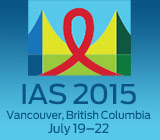 Merck’s next-generation non-nucleoside reverse transcriptase inhibitor (NNRTI, or non-nuke) doravirine (MK-1439) suppresses HIV as well as Sustiva (efavirenz) while leading to half the rate of side effects, aidsmap reports. Researchers conducted a two-part Phase IIb trial investigating different doses of doravirine and then comparing the drug to Sustiva among treatment-naive participants. They presented their findings at the 8th International AIDS Society Conference on HIV Pathogenesis, Treatment and Prevention in Vancouver, British Columbia.
Merck’s next-generation non-nucleoside reverse transcriptase inhibitor (NNRTI, or non-nuke) doravirine (MK-1439) suppresses HIV as well as Sustiva (efavirenz) while leading to half the rate of side effects, aidsmap reports. Researchers conducted a two-part Phase IIb trial investigating different doses of doravirine and then comparing the drug to Sustiva among treatment-naive participants. They presented their findings at the 8th International AIDS Society Conference on HIV Pathogenesis, Treatment and Prevention in Vancouver, British Columbia.
In part 1 of the study, 208 people took Truvada (tenofovir/emtricitabine) with either Sustiva or doravirine at a dose of 25 milligrams, 50 mg, 100 mg and 200 mg. Based on week 24 data, the researchers conducted an analysis and chose 100 mg as the best dose, putting all 208 participants taking doravirine on this dose at week 36. For part 2, an additional 132 participants entered the study, randomly assigned to take 100 mg of doravirine or 600 mg of Sustiva, both with Truvada.
The IAS presentation focused on 24-week data from parts 1 and 2, comparing 108 people who took 100 mg of doravirine with 108 people who took Sustiva. Among them the median CD4 cell count was 415.
At 24 weeks, a total of 73.1 percent of the doravirine group and 72.2 percent of the Sustiva group had a viral load below 40, and a respective 88.9 percent and 87 percent had a viral load below 200. The two groups had similar rises in their CD4 levels, at a respective 154 and 146 higher cell counts.
Only 4.6 percent of those on doravirine discontinued treatment for any reason, compared with 11.9 percent of those taking Sustiva. The respective dropout rates due to adverse side effects were 0.9 percent and 5.6 percent.
Most participants had at least one adverse side effect, although just 0.9 percent of the doravirine group had a serious side effect, compared with 4.6 percent of the Sustiva group. A respective 27.8 percent and 55.6 percent of each group had a drug-related side effect. As for central nervous system-related side effects, the respective rates for each treatment group were 9.3 percent and 27.8 percent for dizziness, 6.5 percent and 17.6 percent for abnormal dreams, and 6.5 percent and 8.3 percent for nightmares.
To read the aidsmap article, click here.
Advertisement
Advertisement
Advertisement






Comments
Comments